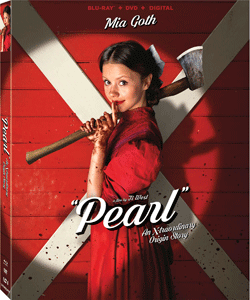Cinephiles knew about writer-director Ti West and actress Mia Goth before 2022, but if “X” didn’t make this their breakout year, its prequel (made during the same production window) solidifies it. “Pearl” explores the villain from the 1979-set “X” by going back to 1918 for a pitch-black comedy and/or movingly tragic origin story.
The shaping of a psychopath
Modern viewers will most likely see “X” first and then “Pearl,” but down the road some will watch them in chronological order. That’ll be fine, because “Pearl” can stand on its own. (SPOILERS FOLLOW.) That’s not to say that West and Goth (who co-writes) don’t get mileage out of our familiarity with “X,” including the farmstead pond that’s home to a roving gator.
But even without knowledge of “X,” “Pearl” is thematically dark enough from the get-go to trade on our grim imaginings of what might happen in any given scene. Like Norman Bates, Pearl (Goth) is simultaneously established as sympathetic and unstable.
“Pearl” (2022)
Director: Ti West
Writers: Ti West, Mia Goth
Stars: Mia Goth, Tandi Wright, Emma Jenkins-Purro
When she’s taking care of her father (Matthew Sunderland), whose brain is mush from the Spanish flu pandemic, there’s always a chance Pearl could “take care of him” in the other sense of the phrase.
Pearl’s psychopathy is perfectly portrayed by Goth. She particularly gets to showcase her acting talent in a spill-all to her bestie (Emma Jenkins-Purro) and in a closing-credits moment where she tries to smile for her husband (Alistair Sewell) who is back from the war.
A glittering lens
The quick turnaround time for “Pearl” suggests it was cranked out, but it doesn’t play that way. The production design, cinematography and horn-driven music take us back to primary-color-laden golden-age Hollywood.
If “X” is 1979 through a 2022 lens, “Pearl” is 1918 through a 1940s lens. Title cards sweep across the screen, backed by an equally sweeping score. Pearl dreams of becoming a star, but she’s stuck on the farm, which – since Pop’s illness — is a subsistence endeavor for her and her strict German mom (Tandi Wright).
A low-level pathetic quality pervades this sheltered girl’s dream, both because it’s a cliché and because she’s farther off the path than she realizes. (“Pearl” is set in Texas, as we know from “X,” although the film doesn’t emphasize this.) The centerpiece dance audition is at a local church, and the gal who wins the spot will be part of a statewide troupe.
It’s not the shortcut to the pictures that Pearl imagines. But West includes a dash of Hollywood dreaminess via Pearl’s secret bicycle jaunts into town to meet the movie house’s handsome projectionist (David Corenswet). The colorful marquee and posters outside evoke “La La Land.”

A little shy of greatness
While West is increasingly making topically daring films, “X” and “Pearl” are shy about going all the way. They both feature good horror imagery (both drawing from “The Texas Chain Saw Massacre”) and end in a grand but expected way.
They leave something on the table. In the case of “Pearl,” it’s Pearl’s sex obsession. While the theater’s facade calls to mind Technicolor and talkies, Pearl – fitting the era — sees black-and-white silent films in the projectionist’s grim booth/lair, including an illegal French sex film.
By “Pearl’s” end, she desperately desires to be loved by anyone. The film’s sex aspect is gone, let alone the divergent kind. Utilizing Goth’s raw sex appeal, an early titillating scene finds Pearl lounging naked in the tub after cleaning up her invalid father, whose wheelchair is still parked there.
“Pearl” ultimately doesn’t want to go there in mixing sex with horror. (That’s the core theme of “X,” but even that film holds back.) It could’ve been a masterful skewering of old Hollywood’s staunch morality by showing the opposite amid visual and aural homages. As it stands, “Pearl” itself is restrained by commercial and ratings concerns, even in 2022.

